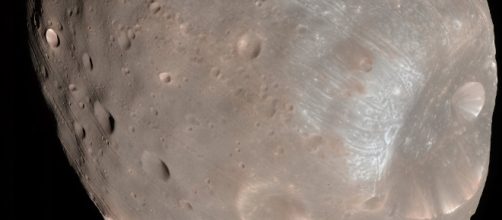The Maven (Mars Atmosphere and Volatile EvolutioN) Spacecraft, is a space probe that has been monitoring the surface and atmosphere of the red planet Mars for the past two years. Originally launched by NASA in November 2013, on board an Atlas V launch vehicle, the MAVEN Spacecraft reached its destination and began orbit on September of 2014. Its mission was to determine how Mars lost the water it once had on its surface as well as the changes in the planet’s atmosphere.
The dying moon, Phobos
Phobos is one of two, small, asteroid-sized moons that orbit above the surface of planet Mars at around 3700 miles (6000 kilometers).
Unlike our own moon, Phobos orbits Mars faster than the planet can rotate, finishing one revolution in a little under 8 hours. From the perspective of someone on the surface of Mars, the moon rises from the western horizon and sets in the east in a little over 4 hours. Since it circles the planet faster than it can rotate, this means that you can see the moon twice in one Martian day. Though the moon rotates close enough to the surface of Mars already, tidal deceleration is decreasing the radius of its orbit by a few meters every century. These tidal forces have a huge impact on the small moon. Grooves that appear on its surface suggest that it is being torn apart and pretty soon, the moon might end up being totally destroyed if it doesn’t crash into the surface of Mars first.
Either way, experts have predicted its total destruction at in around 40 million years.
The MAVEN Spacecraft’s near impact with Phobos
The MAVEN Spacecraft was about to have a close encounter of the devastating kind with Phobos in March of 2017. Since both the artificial and natural satellite are orbiting Mars, it would come to no surprise that every now and then, their orbital paths would cross each other. Usually, NASA mission control takes careful precaution so that the spacecraft never intersects with Phobos. However, in February, a team of researchers noticed that there was an extremely high chance that the two orbiters would crash if extra precautions were not taken. With a week’s notice before the projected impact, mission control was able to successfully maneuver the spacecraft by burning its rocket motor in order to speed up its trajectory. This will allow the MAVEN Spacecraft to miss crashing into Phobos by a mere 2 minutes and 30 seconds, or less.

